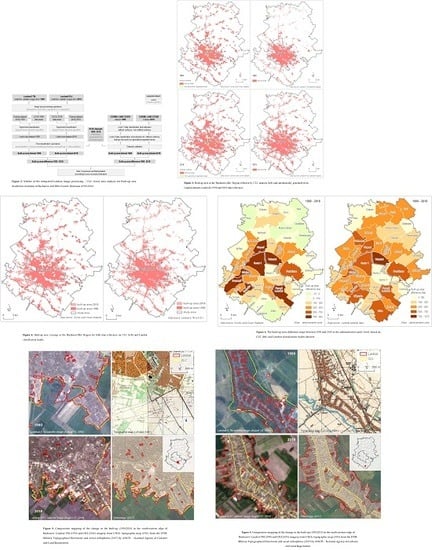Comparative Assessment of the Built-Up Area Expansion Based on Corine Land Cover and Landsat Datasets: A Case Study of a Post-Socialist City
Abstract
:1. Introduction
2. Materials and Methods
2.1. Study Area
2.2. Data Types and Data Sources
2.3. Data Processing, Analysis and Validation Methods
3. Results
3.1. Critical Discrepancies between Corine Land Cover and Landsat Datasets at the Macro-Level
3.2. Spatiotemporal Discrepancies at the Territorial-Administrative Unit’s Level
4. Discussion
4.1. The Magnitude of Built-Up Area Expansion
4.2. Accuracy Assessment of the Results
4.3. Spatial Comparison at the Local Level between Landsat and CLC Datasets
4.4. Key Findings, Limitations and Future Research Directions
5. Conclusions
Author Contributions
Funding
Conflicts of Interest
References
- European Environment Agency. Urban Sprawl in Europe: The Ignored Challenge; European Environment Agency, European Commission, Eds.; Office for Official Publications of the European Communities: Luxembourg, 2006. [Google Scholar]
- Meiner, A.; Pedroli, G.B.M.; European Environment Agency. Landscapes in Transition: An Account of 25 Years of Land Cover Change in Europe; Office for Official Publications of the European Communities: Luxembourg, 2017. [Google Scholar]
- European Environment Agency; Swiss Federal Office for the Environment (FOEN). Urban Sprawl in Europe: Joint EEA-FOEN Report; Office for Official Publications of the European Communities: Luxembourg, 2016. [Google Scholar]
- Hennig, E.I.; Schwick, C.; Soukup, T.; Orlitová, E.; Kienast, F.; Jaeger, J.A.G. Multi-Scale Analysis of Urban Sprawl in Europe: Towards a European de-Sprawling Strategy. Land Use Policy 2015, 49, 483–498. [Google Scholar] [CrossRef] [Green Version]
- Oueslati, W.; Alvanides, S.; Garrod, G. Determinants of Urban Sprawl in European Cities. Urban Stud. 2015, 52, 1594–1614. [Google Scholar] [CrossRef] [PubMed] [Green Version]
- Angel, S.; Parent, J.; Civco, D.L.; Blei, A.; Potere, D. The Dimensions of Global Urban Expansion: Estimates and Projections for All Countries, 2000–2050. Prog. Plan. 2011, 75, 53–107. [Google Scholar] [CrossRef]
- Seto, K.C.; Guneralp, B.; Hutyra, L.R. Global Forecasts of Urban Expansion to 2030 and Direct Impacts on Biodiversity and Carbon Pools. Proc. Natl. Acad. Sci. USA 2012, 109, 16083–16088. [Google Scholar] [CrossRef] [Green Version]
- Seto, K.C.; Fragkias, M.; Güneralp, B.; Reilly, M.K. A Meta-Analysis of Global Urban Land Expansion. PLoS ONE 2011, 6, e23777. [Google Scholar] [CrossRef]
- Khanal, N.; Uddin, K.; Matin, M.; Tenneson, K. Automatic Detection of Spatiotemporal Urban Expansion Patterns by Fusing OSM and Landsat Data in Kathmandu. Remote Sens. 2019, 11, 2296. [Google Scholar] [CrossRef] [Green Version]
- Rimal, B.; Zhang, L.; Keshtkar, H.; Wang, N.; Lin, Y. Monitoring and Modeling of Spatiotemporal Urban Expansion and Land-Use/Land-Cover Change Using Integrated Markov Chain Cellular Automata Model. Isprs Int. J. Geo Inf. 2017, 6, 288. [Google Scholar] [CrossRef] [Green Version]
- Ranagalage, M.; Estoque, R.; Handayani, H.; Zhang, X.; Morimoto, T.; Tadono, T.; Murayama, Y. Relation between Urban Volume and Land Surface Temperature: A Comparative Study of Planned and Traditional Cities in Japan. Sustainability 2018, 10, 2366. [Google Scholar] [CrossRef] [Green Version]
- Rousta, I.; Sarif, M.; Gupta, R.; Olafsson, H.; Ranagalage, M.; Murayama, Y.; Zhang, H.; Mushore, T. Spatiotemporal Analysis of Land Use/Land Cover and Its Effects on Surface Urban Heat Island Using Landsat Data: A Case Study of Metropolitan City Tehran (1988–2018). Sustainability 2018, 10, 4433. [Google Scholar] [CrossRef] [Green Version]
- Grigoraș, G.; Urițescu, B. Land Use/Land Cover Changes Dynamics and Their Effects on Surface Urban Heat Island in Bucharest, Romania. Int. J. Appl. Earth Obs. Geoinf. 2019, 80, 115–126. [Google Scholar] [CrossRef]
- Bai, X.; Dawson, R.J.; Ürge-Vorsatz, D.; Delgado, G.C.; Salisu Barau, A.; Dhakal, S.; Dodman, D.; Leonardsen, L.; Masson-Delmotte, V.; Roberts, D.C.; et al. Six Research Priorities for Cities and Climate Change. Nature 2018, 555, 23–25. [Google Scholar] [CrossRef] [PubMed]
- Larkin, A.; van Donkelaar, A.; Geddes, J.A.; Martin, R.V.; Hystad, P. Relationships between Changes in Urban Characteristics and Air Quality in East Asia from 2000 to 2010. Env. Sci. Technol. 2016, 50, 9142–9149. [Google Scholar] [CrossRef] [PubMed] [Green Version]
- Zaharia, L.; Ioana-Toroimac, G.; Cocoş, O.; Ghiţă, F.A.; Mailat, E. Urbanization Effects on the River Systems in the Bucharest City Region (Romania). Ecosyst. Health Sustain. 2016, 2, e01247. [Google Scholar] [CrossRef] [Green Version]
- Maktav, D.; Sunar, F. Remote Sensing of Urban Land Use Change in Developing Countries: An Example from Büyükçekmece, Istanbul, Turkey. In Remote Sensing of Urban and Suburban Areas; Rashed, T., Jürgens, C., Eds.; Remote Sensing and Digital Image Processing; Springer: Dordrecht, The Netherlands, 2010; Volume 10, pp. 289–312. [Google Scholar] [CrossRef]
- Zambon, I.; Benedetti, A.; Ferrara, C.; Salvati, L. Soil Matters? A Multivariate Analysis of Socioeconomic Constraints to Urban Expansion in Mediterranean Europe. Ecol. Econ. 2018, 146, 173–183. [Google Scholar] [CrossRef]
- Salvia, R.; Serra, P.; Zambon, I.; Cecchini, M.; Salvati, L. In-Between Sprawl and Neo-Rurality: Sparse Settlements and the Evolution of Socio-Demographic Local Context in a Mediterranean Region. Sustainability 2018, 10, 3670. [Google Scholar] [CrossRef] [Green Version]
- Jiang, L.; Deng, X.; Seto, K.C. The Impact of Urban Expansion on Agricultural Land Use Intensity in China. Land Use Policy 2013, 35, 33–39. [Google Scholar] [CrossRef]
- Cao, H.; Liu, J.; Fu, C.; Zhang, W.; Wang, G.; Yang, G.; Luo, L. Urban Expansion and Its Impact on the Land Use Pattern in Xishuangbanna since the Reform and Opening up of China. Remote Sens. 2017, 9, 137. [Google Scholar] [CrossRef] [Green Version]
- McDonald, R.I.; Güneralp, B.; Huang, C.-W.; Seto, K.C.; You, M. Conservation Priorities to Protect Vertebrate Endemics from Global Urban Expansion. Biol. Conserv. 2018, 224, 290–299. [Google Scholar] [CrossRef]
- Güneralp, B.; Seto, K.C. Futures of Global Urban Expansion: Uncertainties and Implications for Biodiversity Conservation. Env. Res. Lett. 2013, 8, 014025. [Google Scholar] [CrossRef]
- Kuemmerle, T.; Levers, C.; Erb, K.; Estel, S.; Jepsen, M.R.; Müller, D.; Plutzar, C.; Stürck, J.; Verkerk, P.J.; Verburg, P.H.; et al. Hotspots of Land Use Change in Europe. Env. Res. Lett. 2016, 11, 064020. [Google Scholar] [CrossRef]
- Leinenkugel, P.; Deck, R.; Huth, J.; Ottinger, M.; Mack, B. The Potential of Open Geodata for Automated Large-Scale Land Use and Land Cover Classification. Remote Sens. 2019, 11, 2249. [Google Scholar] [CrossRef] [Green Version]
- Salvati, L.; Zambon, I.; Chelli, F.M.; Serra, P. Do Spatial Patterns of Urbanization and Land Consumption Reflect Different Socioeconomic Contexts in Europe? Sci. Total Env. 2018, 625, 722–730. [Google Scholar] [CrossRef] [PubMed]
- Pichler-Milanovi, N.; Gutry-Korycka, M.; Rink, D. Sprawl in the Post-Socialist City: The Changing Economic and Institutional Context of Central and Eastern European Cities. In Urban Sprawl in Europe; Couch, C., Leontidou, L., Petschel-Held, G., Eds.; Blackwell Publishing Ltd.: Oxford, UK, 2007; pp. 102–135. [Google Scholar] [CrossRef]
- Hirt, S. Whatever Happened to the (Post)Socialist City? Cities 2013, 32, S29–S38. [Google Scholar] [CrossRef]
- Sýkora, L.; Stanilov, K. The Challenge of Postsocialist Suburbanization. In Confronting Suburbanization; John Wiley & Sons Ltd.: Chichester, UK, 2014; pp. 1–32. [Google Scholar] [CrossRef]
- Nedović-Budić, Z.; Tsenkova, S.; Marcuse, P. The Urban Mosaic of Post-Socialist Europe. In The Urban Mosaic of Post-Socialist Europe; Tsenkova, S., Nedović-Budić, Z., Eds.; Physica-Verlag HD: Heidelberg, Germany, 2006; pp. 3–20. [Google Scholar] [CrossRef]
- Hirt, S. Post-Socialist Urban Forms: Notes From Sofia. Urban Geogr. 2006, 27, 464–488. [Google Scholar] [CrossRef]
- Hirt, S.A. Iron Curtains: Gates, Suburbs and Privatization of Space in the Post-Socialist City; John Wiley & Sons Ltd.: Chichester, UK, 2012. [Google Scholar] [CrossRef]
- Sýkora, L.; Bouzarovski, S. Multiple Transformations: Conceptualising the Post-Communist Urban Transition. Urban Stud. 2011. [Google Scholar] [CrossRef] [Green Version]
- Taubenböck, H.; Gerten, C.; Rusche, K.; Siedentop, S.; Wurm, M. Patterns of Eastern European Urbanisation in the Mirror of Western Trends—Convergent, Unique or Hybrid? Env. Plan. B Urban Anal. City Sci. 2019. [Google Scholar] [CrossRef] [Green Version]
- Gentile, M.; Marcińczak, S. Housing Inequalities in Bucharest: Shallow Changes in Hesitant Transition. GeoJournal 2014, 79, 449–465. [Google Scholar] [CrossRef]
- Ianoș, I. Orașele și Organizarea Spațiului Geografic: Studiu de Geografie Economică asupra Teritoriului României; Editura Academiei Republicii Socialiste Romania: Bucharest, Romania, 1987. [Google Scholar]
- Ianoş, I.; Tălângă, C. Orașul și Sistemul Urban Românesc în Condițiile Economiei de Piață; Institutul de Geografie: Bucharest, Romania, 1994. [Google Scholar]
- Marea Adunare Națională. Lege Nr. 58 Din 1 Noiembrie 1974 Privind Sistematizarea Teritoriului Şi Localităţilor Urbane Şi Rurale; Buletinul Oficial: Bucharest, Romania, 1974; Volume 135. [Google Scholar]
- Suditu, B. Urban Sprawl and Residential Mobilities in the Bucharest Area—Reconfiguration of a New Residential Geography. Hum. Geogr. Stud. Res. Hum. Geogr. 2009, 3, 79–93. [Google Scholar]
- Ianoş, I.; Sîrodoev, I.; Pascariu, G.; Henebry, G. Divergent Patterns of Built-up Urban Space Growth Following Post-Socialist Changes. Urban Stud. 2016, 53, 3172–3188. [Google Scholar] [CrossRef]
- Tomaszewska, M.; Henebry, G. Urban–Rural Contrasts in Central-Eastern European Cities Using a MODIS 4 Micron Time Series. Remote Sens. 2016, 8, 924. [Google Scholar] [CrossRef] [Green Version]
- Ianoş, I.; Sorensen, A.; Merciu, C. Incoherence of Urban Planning Policy in Bucharest: Its Potential for Land Use Conflict. Land Use Policy 2017, 60, 101–112. [Google Scholar] [CrossRef]
- Tosa, C.; Mitrea, A.; Sato, H.; Miwa, T.; Morikawa, T. Economic Growth and Urban Metamorphosis: A Quarter Century of Transformations within the Metropolitan Area of Bucharest. J. Transp. Land Use 2018, 11. [Google Scholar] [CrossRef] [Green Version]
- Schneider, A.; Woodcock, C.E. Compact, Dispersed, Fragmented, Extensive? A Comparison of Urban Growth in Twenty-Five Global Cities Using Remotely Sensed Data, Pattern Metrics and Census Information. Urban Stud. 2008, 45, 659–692. [Google Scholar] [CrossRef]
- Netzband, M.; Jürgens, C. Urban and Suburban Areas as a Research Topic for Remote Sensing. In Remote Sensing of Urban and Suburban Areas; Rashed, T., Jürgens, C., Eds.; Remote Sensing and Digital Image Processing; Springer: Dordrecht, The Netherlands, 2010; Volume 10, pp. 1–9. [Google Scholar] [CrossRef]
- Alqurashi, A.; Kumar, L.; Sinha, P. Urban Land Cover Change Modelling Using Time-Series Satellite Images: A Case Study of Urban Growth in Five Cities of Saudi Arabia. Remote Sens. 2016, 8, 838. [Google Scholar] [CrossRef] [Green Version]
- Maktav, D.; Erbek, F.S.; Jürgens, C. Remote Sensing of Urban Areas. Int. J. Remote Sens. 2005, 26, 655–659. [Google Scholar] [CrossRef]
- Bouhennache, R.; Bouden, T.; Taleb-Ahmed, A.; Cheddad, A. A New Spectral Index for the Extraction of Built-up Land Features from Landsat 8 Satellite Imagery. Geocarto Int. 2019, 34, 1531–1551. [Google Scholar] [CrossRef]
- Besussi, E.; Chin, N.; Batty, M.; Longley, P. The Structure and Form of Urban Settlements. In Remote Sensing of Urban and Suburban Areas; Rashed, T., Jürgens, C., Eds.; Remote Sensing and Digital Image Processing; Springer: Dordrecht, The Netherlands, 2010; Volume 10, pp. 13–31. [Google Scholar] [CrossRef]
- Prastacos, P.; Lagarias, A.; Chrysoulakis, N. Using the Urban Atlas Dataset for Estimating Spatial Metrics. Methodology and Application in Urban Areas of Greece. Cybergeo 2017. [Google Scholar] [CrossRef]
- Hirt, S.; Stanilov, K. Revisiting Urban Planning in the Transitional Countries. Unpublished Regional Study Prepared for Planning Sustainable Cities: Global Report on Human Settlements; GRHS: Bismarck, ND, USA, 2009. [Google Scholar]
- Leetmaa, K.; Tammaru, T.; Anniste, K. From Priority-Led To Market-Led Suburbanisation in a Post-Communist Metropolis. Tijdschr Voor Econ. En Soc. Geogr. 2009, 100, 436–453. [Google Scholar] [CrossRef]
- Krisjane, Z.; Berzins, M. Post-Socialist Urban Trends: New Patterns and Motivations for Migration in the Suburban Areas of Rīga, Latvia. Urban Stud. 2012, 49, 289–306. [Google Scholar] [CrossRef]
- Slaev, A.D.; Nedović-Budić, Z.; Krunić, N.; Petrić, J.; Daskalova, D. Suburbanization and Sprawl in Post-Socialist Belgrade and Sofia. Eur. Plan. Stud. 2018, 26, 1389–1412. [Google Scholar] [CrossRef]
- Spórna, T.; Krzysztofik, R. ‘Inner’ Suburbanisation–Background of the Phenomenon in a Polycentric, Post-Socialist and Post-Industrial Region. Example from the Katowice Conurbation, Poland. Cities 2020, 104, 102789. [Google Scholar] [CrossRef]
- Diermayer, E.; Hostert, P. Assessing Post-Socialist Urban Change with Landsat Data Case Study Berlin, Germany. In Proceedings of the 2007 Urban Remote Sensing Joint Event, Paris, France, 11–13 April 2007; IEEE: Piscataway, NJ, USA, 2007; pp. 1–4. [Google Scholar] [CrossRef]
- Kovács, Z.; Farkas, Z.J.; Egedy, T.; Kondor, A.C.; Szabó, B.; Lennert, J.; Baka, D.; Kohán, B. Urban Sprawl and Land Conversion in Post-Socialist Cities: The Case of Metropolitan Budapest. Cities 2019, 92, 71–81. [Google Scholar] [CrossRef]
- Pazúr, R.; Feranec, J.; Štych, P.; Kopecká, M.; Holman, L. Changes of Urbanised Landscape Identified and Assessed by the Urban Atlas Data: Case Study of Prague and Bratislava. Land Use Policy 2017, 61, 135–146. [Google Scholar] [CrossRef]
- Poghosyan, A. Quantifying Urban Growth in 10 Post-Soviet Cities Using Landsat Data and Machine Learning. Int. J. Remote Sens. 2018, 39, 8688–8702. [Google Scholar] [CrossRef]
- Mihai, B.; Nistor, C.; Simion, G. Post-Socialist Urban Growth of Bucharest, Romania – a Change Detection Analysis on Landsat Imagery (1984–2010). Acta Geogr. Slov. 2015, 55. [Google Scholar] [CrossRef] [Green Version]
- Aldea, M.; Petrescu, F.; Parlow, E.; Iacoboaea, C.; Luca, O.; Sercaianu, M.; Gaman, F. Demonstrative Potential of Multitemporal Satellite Imagery. In Documenting Urban Dynamics: Generalisation from the Bucharest City Case; Themistocleous, K., Hadjimitsis, D.G., Michaelides, S., Papadavid, G., Eds.; Proc. SPIE 9688: Paphos, Cyprus, 2016; p. 96881X. [Google Scholar] [CrossRef]
- Kucsicsa, G.; Grigorescu, I. Urban Growth in the Bucharest Metropolitan Area: Spatial and Temporal Assessment Using Logistic Regression. J. Urban Plan. Dev. 2018, 144, 05017013. [Google Scholar] [CrossRef]
- Simion, G. The Spatial Changes of Land Use in The Bucharest Metropolitan Area 1970s–2000s. Hum. Geogr. J. Stud. Res. Hum. Geogr. 2010, 4, 115–123. [Google Scholar] [CrossRef]
- Simion, G.; Rusu, M. Land Use Patterns: Key Element of Quality of Life in the Metropolitan Area of Bucharest. In Multidimensional Approach to Quality of Life Issues; Sinha, B.R.K., Ed.; Springer: Singapore, 2019; pp. 343–358. [Google Scholar] [CrossRef]
- Diaz-Pacheco, J.; Gutiérrez, J. Exploring the Limitations of CORINE Land Cover for Monitoring Urban Land-Use Dynamics in Metropolitan Areas. J. Land Use Sci. 2014, 9, 243–259. [Google Scholar] [CrossRef]
- Feranec, J.; Soukup, T.; Hazeu, G.; Jaffrain, G. European Landscape Dynamics: CORINE Land Cover Data; CRC Press: Boca Raton, FL, USA, 2016. [Google Scholar] [CrossRef]
- Schneider, A. Monitoring Land Cover Change in Urban and Peri-Urban Areas Using Dense Time Stacks of Landsat Satellite Data and a Data Mining Approach. Remote Sens. Env. 2012, 124, 689–704. [Google Scholar] [CrossRef]
- Samal, D.R.; Gedam, S.S. Monitoring Land Use Changes Associated with Urbanization: An Object Based Image Analysis Approach. Eur. J. Remote Sens. 2015, 48, 85–99. [Google Scholar] [CrossRef]
- Patino, J.E.; Duque, J.C. A Review of Regional Science Applications of Satellite Remote Sensing in Urban Settings. Comput. Env. Urban Syst. 2013, 37, 1–17. [Google Scholar] [CrossRef]
- Andrusz, G.; Harloe, M.; Szelenyi, I. (Eds.) Cities After Socialism; Blackwell Publishers Ltd.: Oxford, UK, 1996. [Google Scholar] [CrossRef]
- Institutul Național de Statistică (National Institute os Statistics). Anuarul Statistic al României-Serii de Timp (CD-ROM); Institutul Național de Statistică: Bucharest, Romania, 2020. [Google Scholar]
- Koceva, M.M.; Brandmüller, T.; Lupu, I.; Önnerfors, Å.; Corselli-Nordblad, L.; Coyette, C.; Johansson, A.; Strandell, H.; Wolff, P. Urban Europe: Statistics on Cities, Towns and Suburbs, 2016th ed.; Europäische Kommission, Ed.; Statistical books/Eurostat; Publications Office of the European Union: Luxembourg, 2016. [Google Scholar]
- Hess, D.B.; Tammaru, T.; van Ham, M. Lessons Learned from a Pan-European Study of Large Housing Estates: Origin, Trajectories of Change and Future Prospects. In Housing Estates in Europe: Poverty, Ethnic Segregation and Policy Challenges; Hess, D.B., Tammaru, T., van Ham, M., Eds.; Springer International Publishing: Cham, Switzerland, 2018; pp. 3–31. [Google Scholar] [CrossRef] [Green Version]
- Marin, V.; Chelcea, L. The Many (Still) Functional Housing Estates of Bucharest, Romania: A Viable Housing Provider in Europe’s Densest Capital City. In Housing Estates in Europe: Poverty, Ethnic Segregation and Policy Challenges; Hess, D.B., Tammaru, T., van Ham, M., Eds.; Springer International Publishing: Cham, Switzerland, 2018; pp. 167–190. [Google Scholar] [CrossRef] [Green Version]
- Ianoş, I. Dinamica Urbană: Aplicaţii la Oraşul și Sistemul Urban Românesc; Editura Tehnică: Bucharest, Romania, 2004. [Google Scholar]
- Ianoş, I.; Petrişor, A.-I.; Zamfir, D.; Cercleux, A.L.; Stoica, I.V.; Tălângă, C. In Search of a Relevant Index Measuring Territorial Disparities in a Transition Country. Romania as a Case Study. Erde J. Geogr. Soc. Berl. 2013, 144, 69–81. [Google Scholar] [CrossRef]
- Pîrvu, R.; Bădîrcea, R.; Manta, A.; Lupăncescu, M. The Effects of the Cohesion Policy on the Sustainable Development of the Development Regions in Romania. Sustainability 2018, 10, 2577. [Google Scholar] [CrossRef] [Green Version]
- Popescu, C. Foreign Direct Investments and Regional Development in Romania. Rev Roum. Géogrrom. J. Geogr. 2012, 56, 61–70. [Google Scholar]
- European Commission; Statistical Office of the European Union. Eurostat Regional Yearbook: 2019 Edition; 2019. Available online: https://ec.europa.eu/eurostat/documents/3217494/10095393/KS-HA-19%E2%80%91001-EN-N.pdf/d434affa-99cd-4ebf-a3e3-6d4a5f10bb07 (accessed on 5 February 2020).
- Stoica, I.V.; Tălângă, C.; Braghină, C.; Zamfir, D. Ways of Managing the Urban-Rural Interface. Case Study: Bucharest. An. Univ. Din Oradea–Ser. Geogr. 2011, 21, 313–322. [Google Scholar]
- Ianoș, I.; Sîrodoev, I.; Pascariu, G. Built-up Space Dynamics Complicates the Present-Day Urban Land Use in Bucharest. An. Univ. Din Oradea-Ser. Geogr. 2012, 22, 48–53. [Google Scholar]
- Ianoş, I.; Cercleux, A.-L.; Pintilii, R.-D. Remarks on Identity Building of Rural and Urban Communities in the Bucharest Metropolitan Area. An. Univ. Din Oradea–Ser. Geogr. 2010, 20, 173–183. [Google Scholar]
- European Environment Agency. Corine Land Cover (CLC) 2018, Version 20b2. Available online: https://land.copernicus.eu/pan-european/corine-land-cover/clc2018 (accessed on 20 January 2020).
- Sandric, I.; Mihai, B.; Savulescu, I.; Suditu, B.; Chitu, Z. Change Detection Analysis for Urban Development in Bucharest-Romania, Using High Resolution Satellite Imagery. In Proceedings of the 2007 Urban Remote Sensing Joint Event, Paris, France, 1–13 April 2007; IEEE: Piscataway, NJ, USA, 2007; pp. 1–8. [Google Scholar] [CrossRef]
- Roy, D.P.; Wulder, M.A.; Loveland, T.R.; Woodcock, C.E.; Allen, R.G.; Anderson, M.C.; Helder, D.; Irons, J.R.; Johnson, D.M.; Kennedy, R.; et al. Landsat-8: Science and Product Vision for Terrestrial Global Change Research. Remote Sens. Env. 2014, 145, 154–172. [Google Scholar] [CrossRef] [Green Version]
- Vermote, E.; Justice, C.; Claverie, M.; Franch, B. Preliminary Analysis of the Performance of the Landsat 8/OLI Land Surface Reflectance Product. Remote Sens. Env. 2016, 185, 46–56. [Google Scholar] [CrossRef]
- Ottinger, M.; Kuenzer, C.; Liu, G.; Wang, S.; Dech, S. Monitoring Land Cover Dynamics in the Yellow River Delta from 1995 to 2010 Based on Landsat 5 TM. Appl. Geogr. 2013, 44, 53–68. [Google Scholar] [CrossRef]
- Rujoiu-Mare, M.-R.; Olariu, B.; Mihai, B.-A.; Nistor, C.; Săvulescu, I. Land Cover Classification in Romanian Carpathians and Subcarpathians Using Multi-Date Sentinel-2 Remote Sensing Imagery. Eur. J. Remote Sens. 2017, 50, 496–508. [Google Scholar] [CrossRef] [Green Version]
- “Danube Delta” National Institute For Research And Development. Available online: http://ddni.ro/wps/ro/project/corine-land-cover-2018_ro/ (accessed on 16 January 2020).
- Tso, B.; Mather, P.M. Classification Methods for Remotely Sensed Data, 2nd ed.; CRC Press: Boca Raton, FL, USA, 2009. [Google Scholar]
- National Agency for Cadastre and Land Registration. Ortophotos, 2017, 0.5 m spatial resolution, digital geospatial dataset in Stereographic 1970 national projection, RGB imagery, 2017.
- Campbell, J.B.; Wynne, R.H. Introduction to Remote Sensing, 5th ed.; Guilford Press: New York, NY, USA, 2011. [Google Scholar]
- Romanian Military Mapping Directorate. Topographic Maps of Romania scale 1:25,000, Georeferenced in Stereographic 1970 national projection; Romanian Military Mapping Directorate: Bucharest, Romania, 1982. [Google Scholar]
- Chuvieco, E. Fundamentals of Satellite Remote Sensing: An Environmental Approach, 2nd ed.; CRC Press: Boca Raton, FL, USA, 2016. [Google Scholar] [CrossRef]
- Congalton, R.G. A Review of Assessing the Accuracy of Classifications of Remotely Sensed Data. Remote Sens. Env. 1991, 37, 35–46. [Google Scholar] [CrossRef]
- Foody, G.M. Status of Land Cover Classification Accuracy Assessment. Remote Sens. Env. 2002, 80, 185–201. [Google Scholar] [CrossRef]
- Pătroescu, M.; Vânău, G.; Niţă, M.R.; Iojă, C.; Iojă, A. Land Use Change in the Bucharest Metropolitan Area and Its Impacts on the Quality of the Environment in Residential Developments. Forum Geogr. 2011, 10, 177–186. [Google Scholar] [CrossRef]
- Dumitrache, L.; Zamfir, D.; Nae, M.M.; Simion, G.; Stoica, V. The Urban Nexus: Contradictions and Dilemmas of (Post)Communist (Sub)Urbanization in Romania. Hum. Geogr. J. Stud. Res. Hum. Geogr. 2016, 10, 38–50. [Google Scholar] [CrossRef] [Green Version]
- Nae, M.; Turnock, D. The New Bucharest: Two Decades of Restructuring. Cities 2011, 28, 206–219. [Google Scholar] [CrossRef]
- Simion, G.; Nistor, C. Spatial Structure Changes inside Post-Communist Capital City of Bucharest. Hum. Geogr. J. Stud. Res. Hum. Geogr. 2012, 6, 79–89. [Google Scholar] [CrossRef]
- Tălânga, C.; Zamfir, D.; Stoica, I.-V. Urban-Rural Interface, Polycentric Development and Transportation Systems. Case Study: Bucharest Metropolitan Area. Hum. Geogr. J. Stud. Res. Hum. Geogr. 2010, 4, 47–52. [Google Scholar]
- Planul de Mobilitate Urbană Durabilă 2016-2030 Regiunea București–Ilfov. 2016. Available online: https://tpbi.ro/files/proiect_pmud.pdf (accessed on 20 January 2020).
- Guvernul României. Ordonanța de Urgență Nr. 51/2018 Pentru Modificarea Legii Nr. 350/2001 Privind Amenajarea Teritoriului Și Urbanismul Și Pentru Prorogarea Unor Termene; Monitorul official: Bucharest, Romania, 2018; Volume 520. [Google Scholar]
- McNeill, D. Dysfunctional Urbanism. Int. J. Urban Reg. Res. 2005, 29, 201–204. [Google Scholar] [CrossRef]
- Petrişor, A.-I.; Ianoş, I.; Tălângă, C. Land Cover and Use Changes Focused on the Urbanization Processes in Romania. Env. Eng. Manag. J. 2010, 9, 765–771. [Google Scholar] [CrossRef]
- Iojă, C.I.; Niţă, M.R.; Vânău, G.O.; Onose, D.A.; Gavrilidis, A.A. Using Multi-Criteria Analysis for the Identification of Spatial Land-Use Conflicts in the Bucharest Metropolitan Area. Contemp. Concepts Nov. Methods Foster. Indic. Based Approach Urban Complexities 2014, 42, 112–121. [Google Scholar] [CrossRef]
- Ianoș, I.; Merciu, F.C.; Merciu, G.; Zamfir, D.; Stoica, I.-V.; Vlăsceanu, G. Unclear Perspectives for a Specific Intra-Urban Space: Văcărești Lake Area (Bucharest City). Carpathian J. Earth Env. Sci. 2014, 9, 215–224. [Google Scholar]
- Merciu, F.C.; Sîrodoev, I.; Merciu, G.; Zamfir, D.; Schvab, A.; Stoica, I.V.; Paraschiv, M.; Saghin, I.; Cercleux, A.L.; Văidianu, N.; et al. The “Văcărești Lake” Protected Area, a Neverending Debatable Issue? Carpathian J. Earth Env. Sci. 2017, 12, 463–472. [Google Scholar]
- Ianos, I.; Zamfir, D.; Stoica, V.; Cercleux, L.; Schvab, A.; Pascariu, G. Municipal solid waste management for sustainable development of bucharest metropolitan area. Env. Eng. Manag. J. 2012, 11, 359–369. [Google Scholar] [CrossRef]
- ARCADIS. Stația de Epurare a Apelor Uzate Glina București Faza II (România). Planul de Implicare a Părților Interesate; ARCADIS: Amsterdam, The Netherlands, 2017. [Google Scholar]
- Suditu, B.; Ginavar, A.; Muică, A.; Iordăchescu, A.; Vârdol, A.; Ghinea Bogdan. Urban Sprawl Characteristics and Typologies in Romania. Hum. Geogr. J. Stud. Res. Hum. Geogr. 2010, 4, 79–87. [Google Scholar]
- Suditu, B. Urban Sprawl–the Legal Context and Territorial Practices in Romania. Hum. Geogr. J. Stud. Res. Hum. Geogr. 2012, 6, 73–77. [Google Scholar] [CrossRef] [Green Version]
- Iojă, C.I.; Tudor, C.A. Temporal Analysis of Incompatible Land-Use and Land-Cover: The Proximity between Residential Areas and Gas Stations in Bucharest Suburban Area. In Proceedings of the 2011 International Conference Environment–Landscape–European Identity, Bucharest, Romania, 4–6 November 2012; Volume 14, pp. 49–58. [Google Scholar] [CrossRef] [Green Version]
- Grădinaru, S.R.; Iojă, C.I.; Onose, D.A.; Gavrilidis, A.A.; Pătru-Stupariu, I.; Kienast, F.; Hersperger, A.M. Land Abandonment as a Precursor of Built-up Development at the Sprawling Periphery of Former Socialist Cities. Ecol. Indic. 2015, 57, 305–313. [Google Scholar] [CrossRef]
- Petrișor, A.-I. Land Cover and Land Use Analysis of Urban Growth in Romania. Hum. Geogr. J. Stud. Res. Hum. Geogr. 2012, 6, 47–51. [Google Scholar] [CrossRef] [Green Version]
- Ianoş, I.; Petrişor, A.-I.; Stoica, I.V.; Sârbu, C.N.; Zamfir, D.; Cercleux, A.-L. The Different Consuming of Primary Eco-Energies and Their Degradation in Territorial Systems. Carpathian J. Earth Env. Sci. 2011, 6, 251–260. [Google Scholar]
- Petrişor, A.-I. Long Term Urbanization within and around the Large Cities in Developing Countries: A Romanian Perspective on the Main Transitional Dynamics. Alger. J. Eng. Arch. Urban. 2017, 1, 14–19. [Google Scholar]
- Yang, C.; Li, Q.; Zhao, T.; Liu, H.; Gao, W.; Shi, T.; Guan, M.; Wu, G. Detecting Spatiotemporal Features and Rationalities of Urban Expansions within the Guangdong–Hong Kong–Macau Greater Bay Area of China from 1987 to 2017 Using Time-Series Landsat Images and Socioeconomic Data. Remote Sens. 2019, 11, 2215. [Google Scholar] [CrossRef] [Green Version]
- Pflugmacher, D.; Rabe, A.; Peters, M.; Hostert, P. Mapping Pan-European Land Cover Using Landsat Spectral-Temporal Metrics and the European LUCAS Survey. Remote Sens. Env. 2019, 221, 583–595. [Google Scholar] [CrossRef]
- Petrişor, A.-I.; Petrişor, L.E. Assessing Microscale Environmental Changes: CORINE Vs. The Urban Atlas. Present Env. Sustain. Dev. 2015, 9, 95–104. [Google Scholar] [CrossRef] [Green Version]
- Mesev, V. Classification of Urban Areas: Inferring Land Use from the Interpretation of Land Cover. In Remote Sensing of Urban and Suburban Areas; Rashed, T., Jürgens, C., Eds.; Remote Sensing and Digital Image Processing; Springer: Dordrecht, The Netherlands, 2010; Volume 10, pp. 141–164. [Google Scholar] [CrossRef]
- Jia, K.; Wei, X.; Gu, X.; Yao, Y.; Xie, X.; Li, B. Land Cover Classification Using Landsat 8 Operational Land Imager Data in Beijing, China. Geocarto Int. 2014, 29, 941–951. [Google Scholar] [CrossRef]
- Jia, K.; Liang, S.; Zhang, N.; Wei, X.; Gu, X.; Zhao, X.; Yao, Y.; Xie, X. Land Cover Classification of Finer Resolution Remote Sensing Data Integrating Temporal Features from Time Series Coarser Resolution Data. ISPRS J. Photogramm. Remote Sens. 2014, 93, 49–55. [Google Scholar] [CrossRef]
- Gong, W.; Yuan, L.; Fan, W.; Wang, X.; Stott, P. Comparison to Supervised Classification Modelling in Land Use Cover Using Landsat 8 OLI Data: An Example in Miyun County of North China. Nat. Env. Pollut. Technol. 2016, 15, 243–248. [Google Scholar]
- Lee, J.K.; Acharya, T.D.; Lee, D.H. Exploring Land Cover Classification Accuracy of Landsat 8 Image Using Spectral Index Layer Stacking in Hilly Region of South Korea. Sens. Mater. 2018, 30, 2927. [Google Scholar] [CrossRef]
- Griffiths, P.; Nendel, C.; Hostert, P. Intra-Annual Reflectance Composites from Sentinel-2 and Landsat for National-Scale Crop and Land Cover Mapping. Remote Sens. Env. 2019, 220, 135–151. [Google Scholar] [CrossRef]
- Bayramov, E.; Buchroithner, M.; Bayramov, R. Quantitative Assessment of 2014–2015 Land-Cover Changes in Azerbaijan Using Object-Based Classification of LANDSAT-8 Timeseries. Model. Earth Syst. Env. 2016, 2, 35. [Google Scholar] [CrossRef] [Green Version]
- Feng, D.; Zhao, Y.; Yu, L.; Li, C.; Wang, J.; Clinton, N.; Bai, Y.; Belward, A.; Zhu, Z.; Gong, P. Circa 2014 African Land-Cover Maps Compatible with FROM-GLC and GLC2000 Classification Schemes Based on Multi-Seasonal Landsat Data. Int. J. Remote Sens. 2016, 37, 4648–4664. [Google Scholar] [CrossRef]
- Mushore, T.D.; Mutanga, O.; Odindi, J.; Dube, T. Assessing the Potential of Integrated Landsat 8 Thermal Bands, with the Traditional Reflective Bands and Derived Vegetation Indices in Classifying Urban Landscapes. Geocarto Int. 2017, 32, 886–899. [Google Scholar] [CrossRef]
- Liu, Q.; Liu, G. Combining Tasseled Cap Transformation with Support Vector Machine to Classify Landsat TM Imagery Data. In Proceedings of the 2010 Sixth International Conference on Natural Computation, Yantai, China, 10–12 August 2010; IEEE: Piscataway, NJ, USA, 2010; pp. 3570–3572. [Google Scholar] [CrossRef]
- Li, S.; Chen, X. A New Bare-Soil Index for Rapid Mapping Developing Areas Using LANDSAT 8 Data. ISPRS Int. Arch. Photogramm. Remote Sens. Spat. Inf. Sci. 2014, 40, 139–144. [Google Scholar] [CrossRef] [Green Version]
- Li, X.; Zhou, W.; Ouyang, Z. Forty Years of Urban Expansion in Beijing: What Is the Relative Importance of Physical, Socioeconomic, and Neighborhood Factors? Appl. Geogr. 2013, 38, 1–10. [Google Scholar] [CrossRef]
- Hua, L.; Zhang, X.; Chen, X.; Yin, K.; Tang, L. A Feature-Based Approach of Decision Tree Classification to Map Time Series Urban Land Use and Land Cover with Landsat 5 TM and Landsat 8 OLI in a Coastal City, China. ISPRS Int. J. Geo Inf. 2017, 6, 331. [Google Scholar] [CrossRef] [Green Version]
- Nguyen Dinh, D. Automated Classification of Land Cover Using Landsat 8 Oli Surface Reflectance Product and Spectral Pattern Analysis Concept - Case Study in Hanoi, Vietnam. ISPRS Int. Arch. Photogramm. Remote Sens. Spat. Inf. Sci. 2016, XLI-B8, 987–991. [Google Scholar] [CrossRef]
- Zhou, Y.; Yang, G.; Wang, S.; Wang, L.; Wang, F.; Liu, X. A New Index for Mapping Built-up and Bare Land Areas from Landsat-8 OLI Data. Remote Sens. Lett. 2014, 5, 862–871. [Google Scholar] [CrossRef]
- Bossard, M.; Feranec, J.; Otahel, J. Corine Land Cover—Technical Guide-Addendum 2000; Technical Report 40; European Environment Agency: Copenhagen, Denmark, 2000. [Google Scholar]
- Feranec, J.; Hazeu, G.; Christensen, S.; Jaffrain, G. Corine Land Cover Change Detection in Europe (Case Studies of the Netherlands and Slovakia). Land Use Policy 2007, 24, 234–247. [Google Scholar] [CrossRef]
- Caetano, M.; Nunes, V.; Nunes, A. CORINE Land Cover 2006 for Continental Portugal; Technical Report; Instituto Geográfico Português: Faro, Portugal, 2009. [Google Scholar]
- Balzter, H.; Cole, B.; Thiel, C.; Schmullius, C. Mapping CORINE Land Cover from Sentinel-1A SAR and SRTM Digital Elevation Model Data Using Random Forests. Remote Sens. 2015, 7, 14876–14898. [Google Scholar] [CrossRef] [Green Version]
- Stathopoulou, M.; Cartalis, C. Daytime Urban Heat Islands from Landsat ETM+ and Corine Land Cover Data: An Application to Major Cities in Greece. Sol. Energy 2007, 81, 358–368. [Google Scholar] [CrossRef]
- Törmä, M.; Härmä, P.; Teiniranta, R.; Repo, R.; Järvenpää, E.; Kallio, E. The Production of Finnish Corine Land Cover 2000 Classification. Prod. Finn. Corine Land Cover 2000 Classif. 2004. [Google Scholar]
- Bronge, L.B.; Näslund-Landenmark, B. Wetland Classification for Swedish CORINE Land Cover Adopting a Semi-Automatic Interactive Approach. Can. J. Remote Sens. 2002, 28, 139–155. [Google Scholar] [CrossRef]
- Yüksel, A.; Akay, A.; Gundogan, R. Using ASTER Imagery in Land Use/Cover Classification of Eastern Mediterranean Landscapes According to CORINE Land Cover Project. Sensors 2008, 8, 1237–1251. [Google Scholar] [CrossRef] [PubMed] [Green Version]
- Pekkarinen, A.; Reithmaier, L.; Strobl, P. Pan-European Forest/Non-Forest Mapping with Landsat ETM+ and CORINE Land Cover 2000 Data. ISPRS J. Photogramm. Remote Sens. 2009, 64, 171–183. [Google Scholar] [CrossRef]
- Yılmaz, R. Monitoring Land Use/Land Cover Changes Using CORINE Land Cover Data: A Case Study of Silivri Coastal Zone in Metropolitan Istanbul. Env. Monit. Assess. 2010, 165, 603–615. [Google Scholar] [CrossRef] [PubMed]
- Martellozzo, F. Forecasting High Correlation Transition of Agricultural Landscapes into Urban Areas: Diachronic Case Study in North Eastern Italy. Int. J. Agric. Env. Inf. Syst. 2012, 3, 22–34. [Google Scholar] [CrossRef] [Green Version]
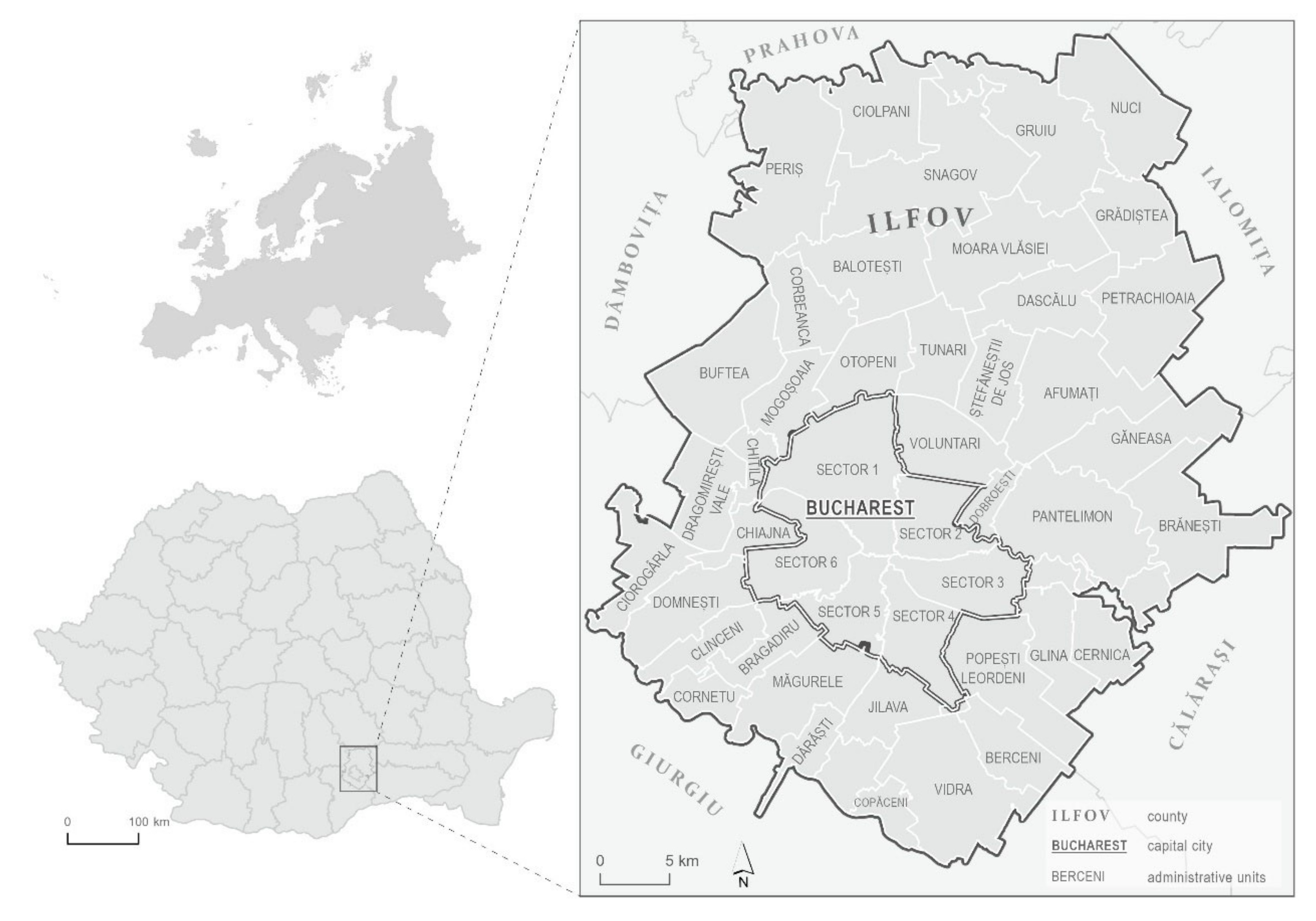

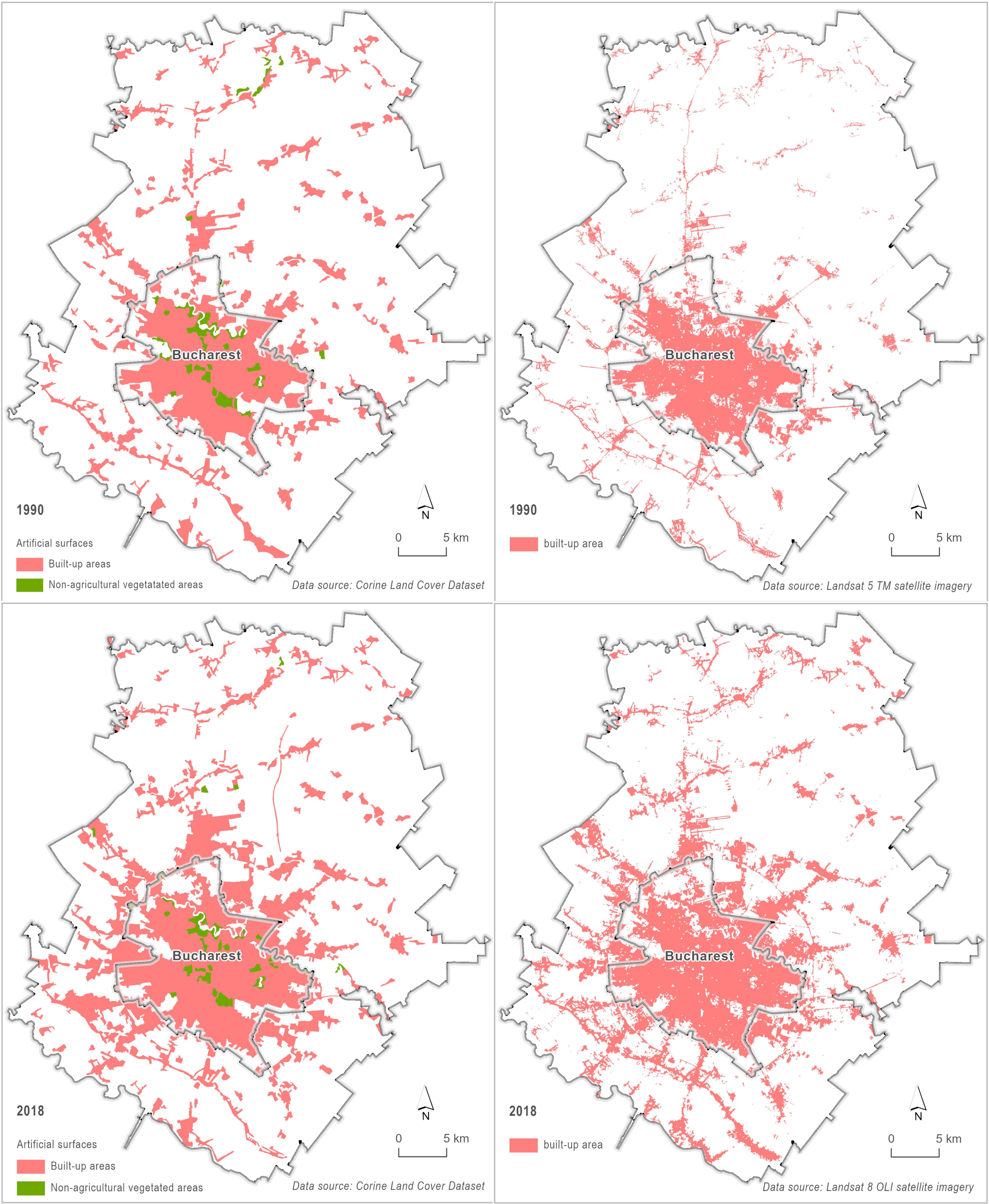
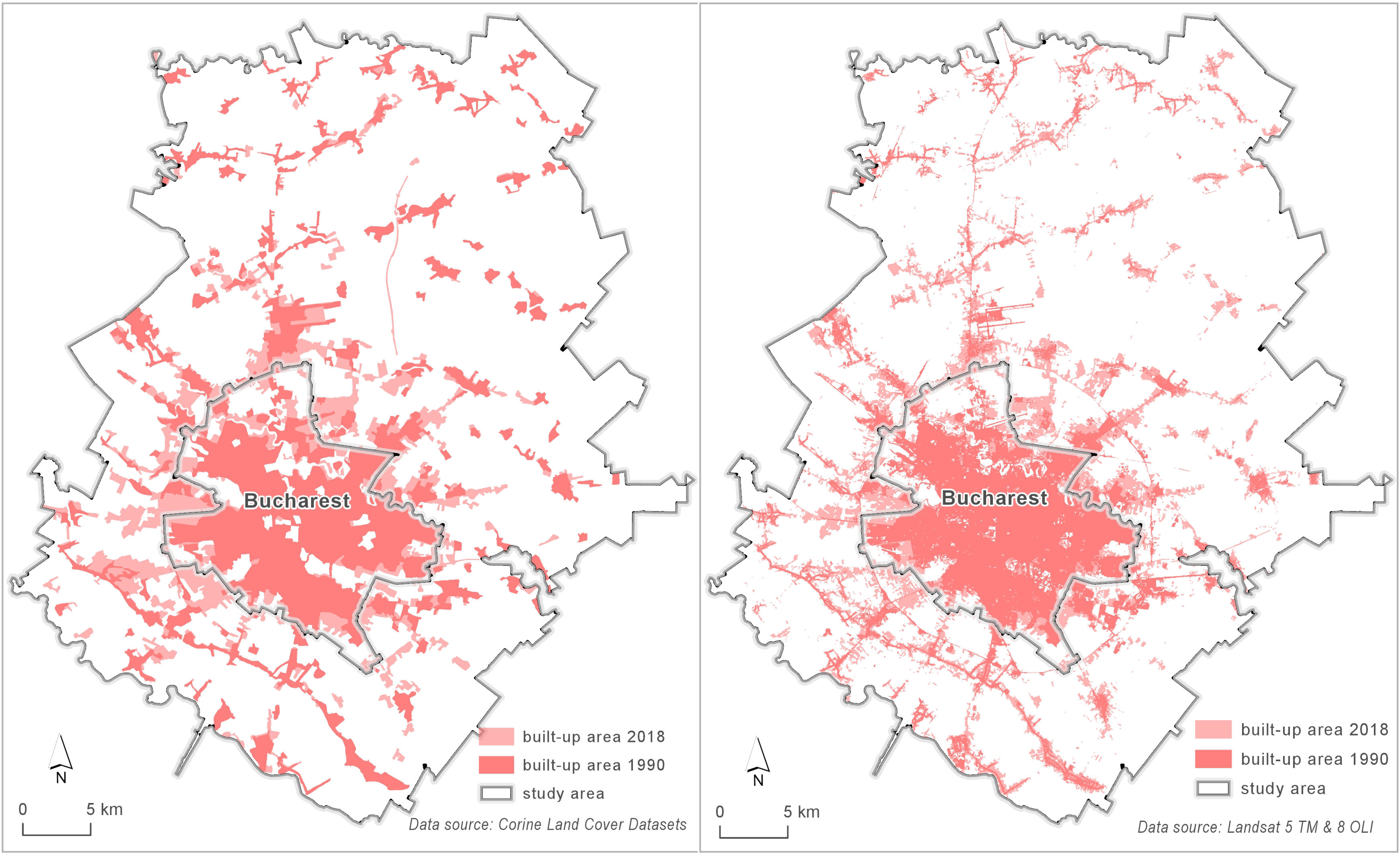
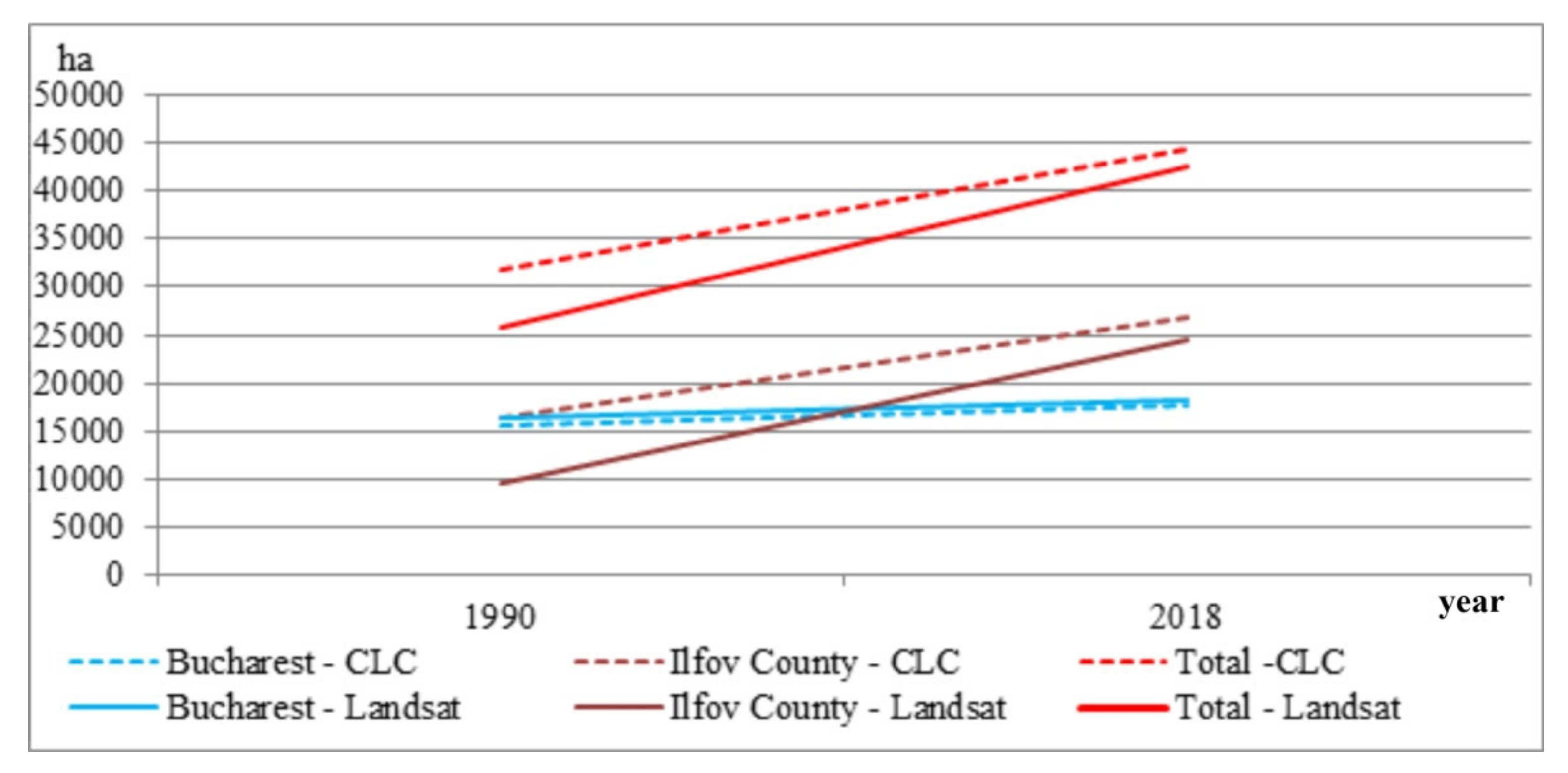
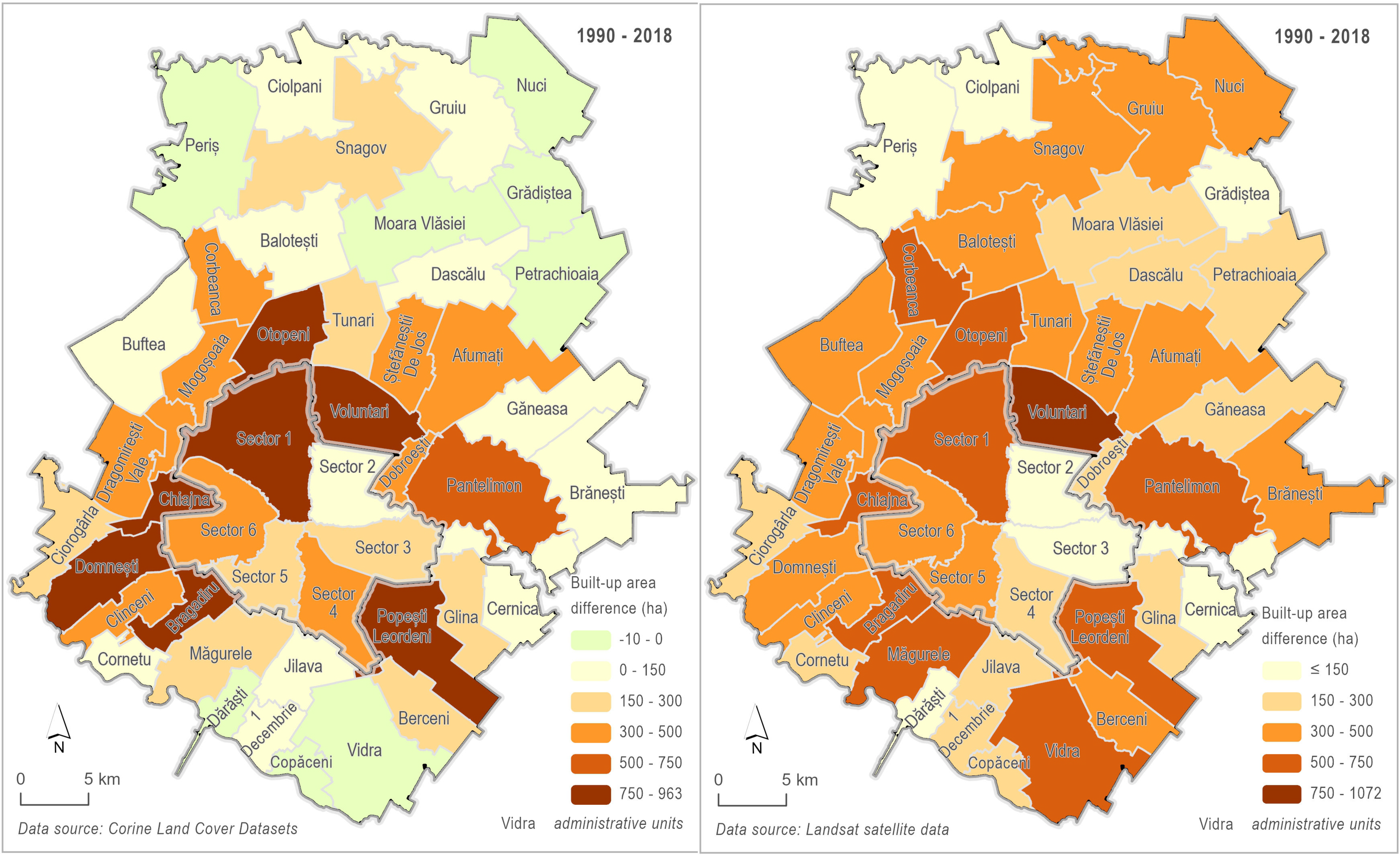
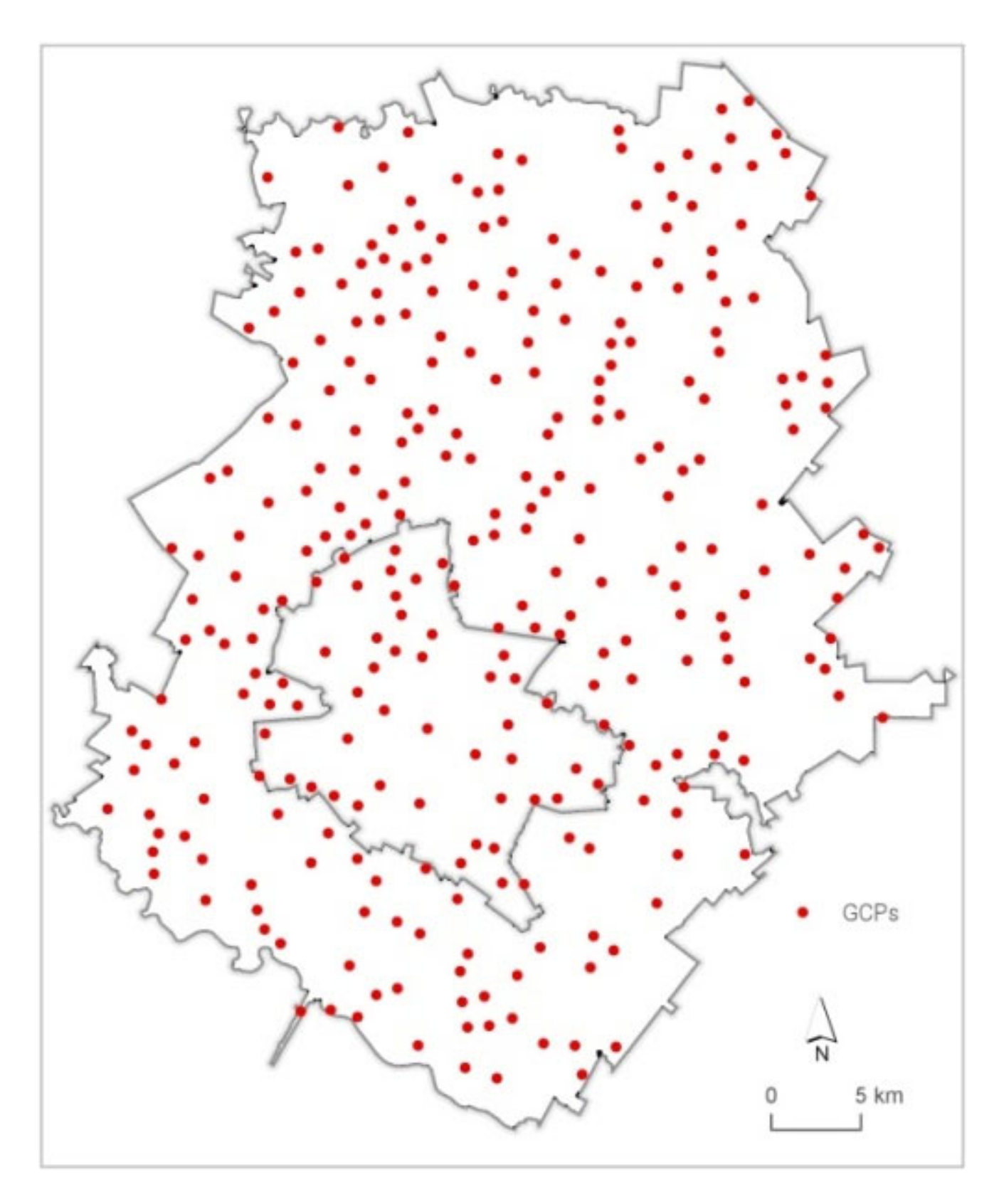
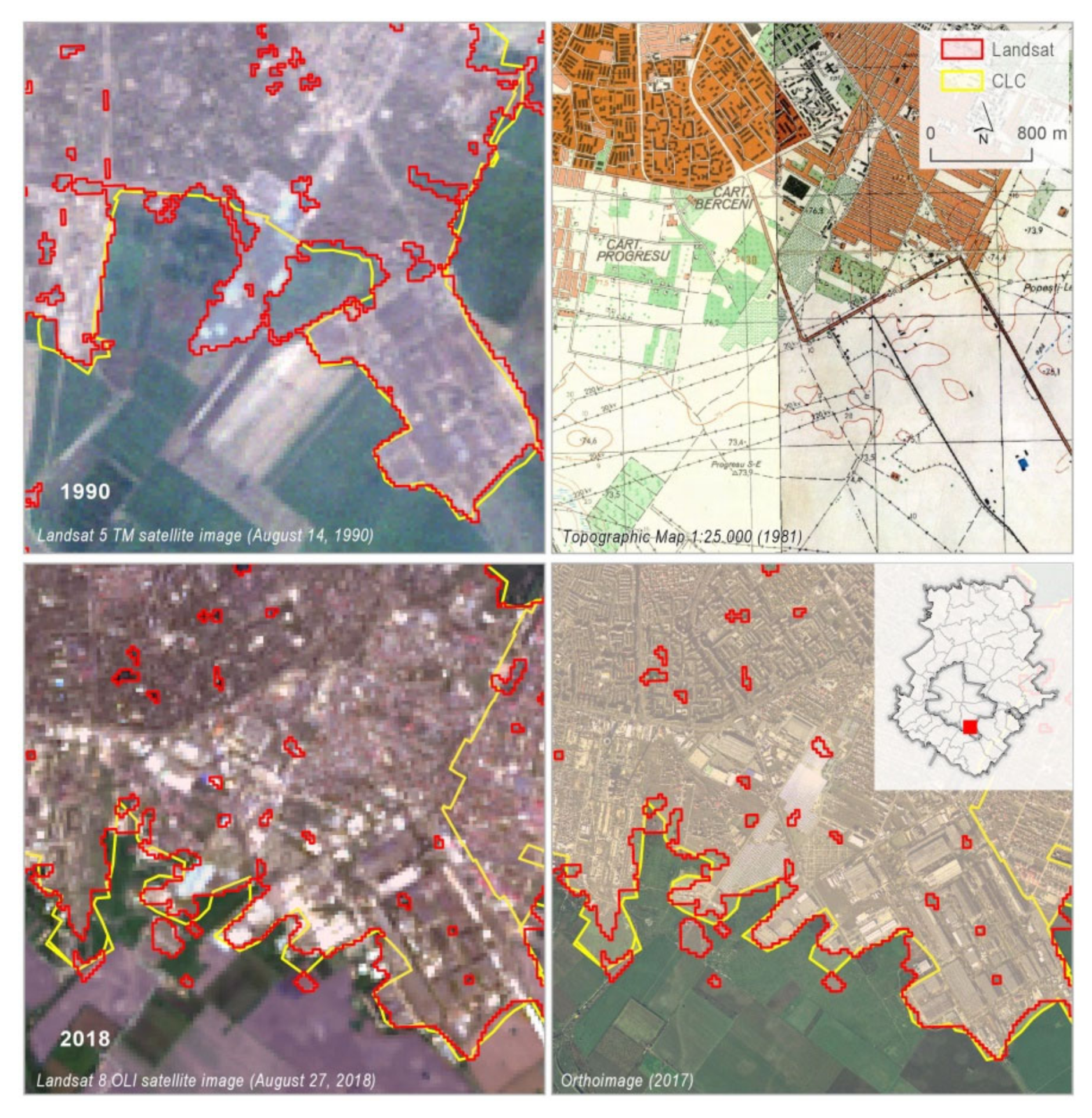
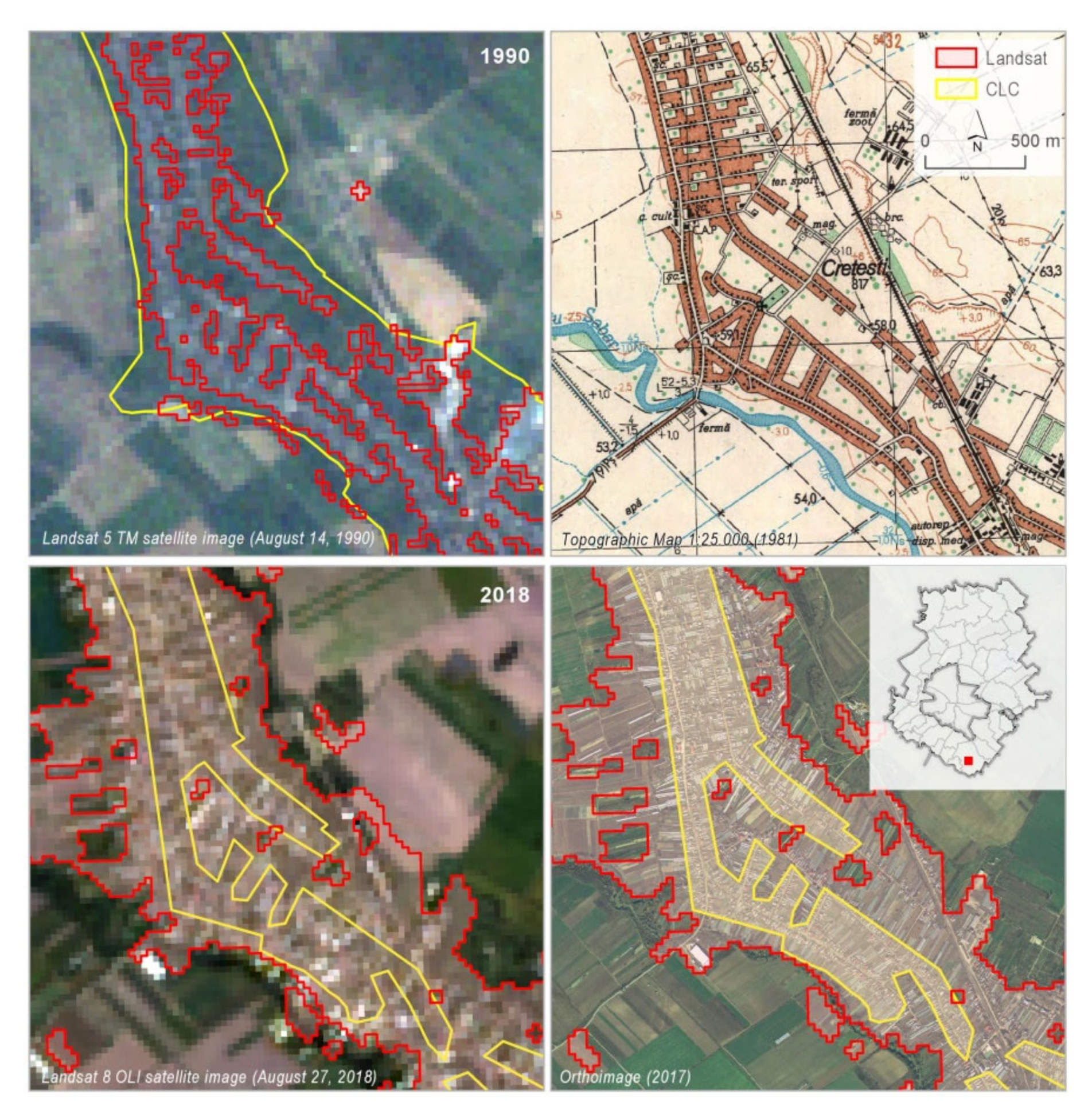
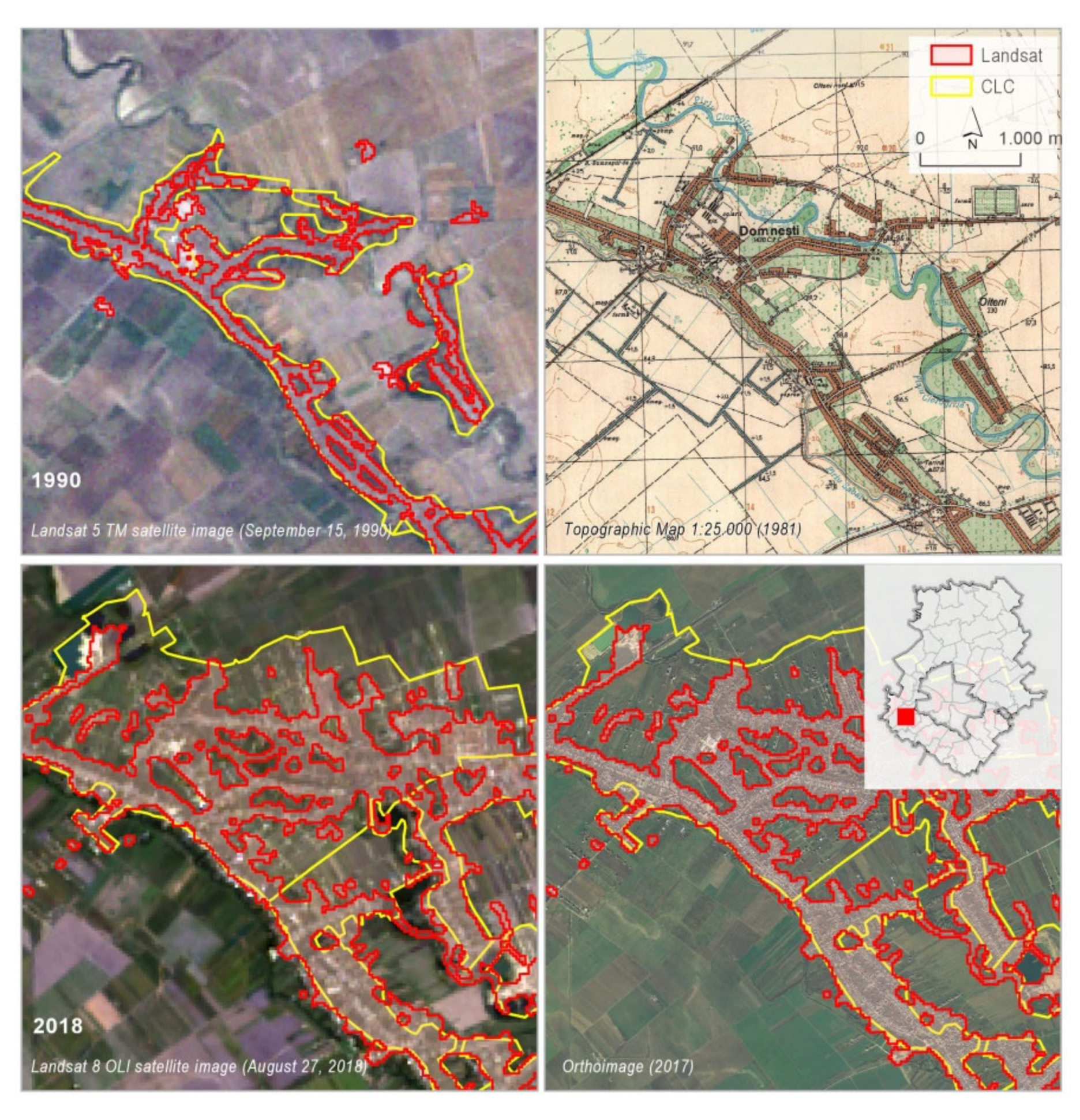

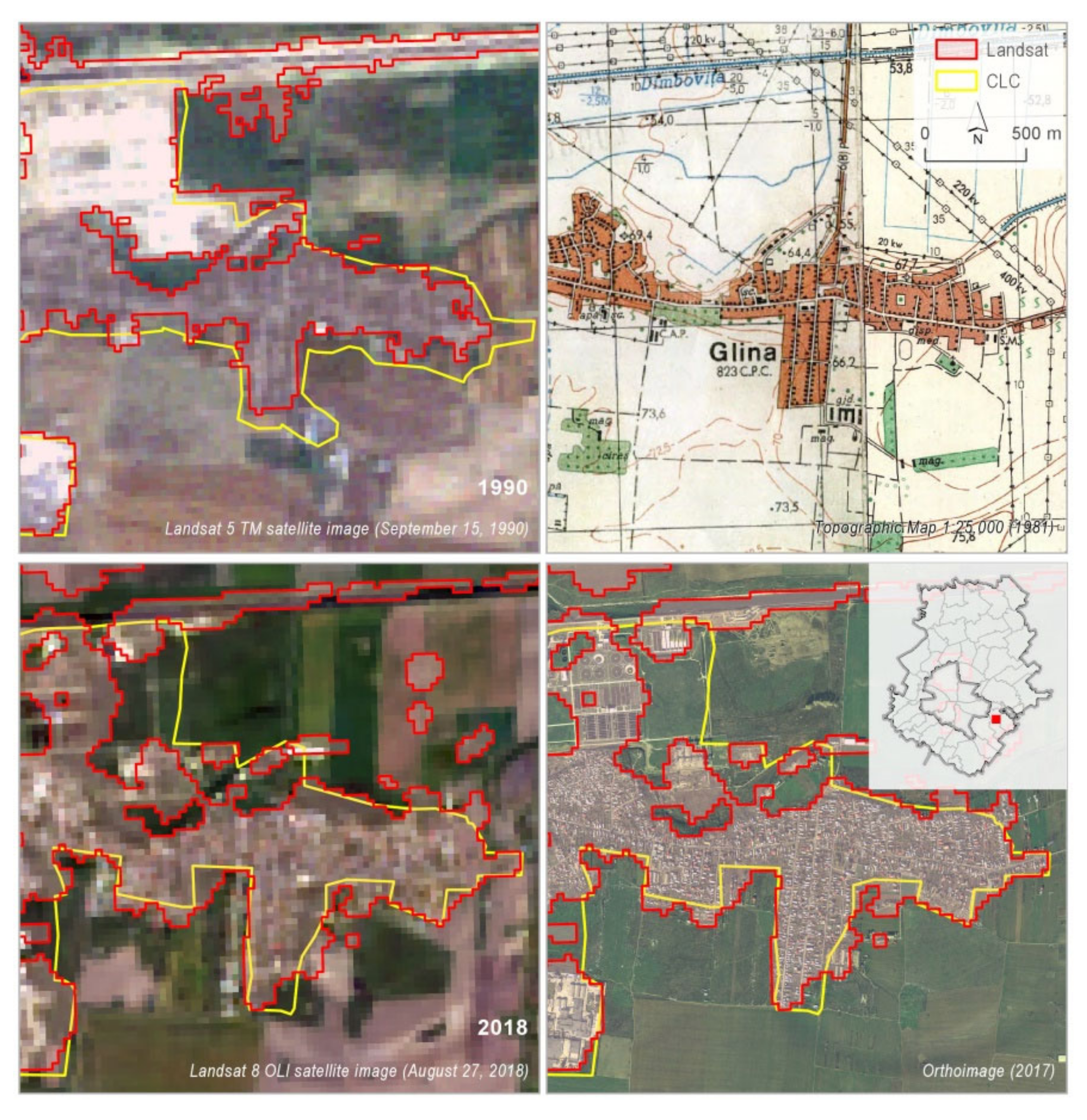
| Dataset | Time Reference | Description | Source |
|---|---|---|---|
| Landsat 5 TM–multidate satellite images | January 5, 1990 January 12, 1990 August 14, 1990 | 6-band multispectral data (raster datasets); 30 m spatial resolution; 8-bits radiometric resolution; | NASA USGS earthexplorer.usgs.gov |
| Landsat 8 OLI–multidate satellite images | January 6, 2018 April 12, 2018 August 27, 2018 September 19, 2018 October 5, 2018 | 7-band multispectral data (raster datasets); 30 m spatial resolution; 16-bits radiometric resolution; | NASA USGS earthexplorer.usgs.gov |
| Corine Land Cover Dataset 1990 | Time consistency 1986–1998 | 25 ha MMU (vector polygon coverage); Extracted from single-date Landsat 5 imagery by visual interpretation; | Copernicus EU land.copernicus.eu |
| Corine Land Cover Dataset 2018 | Time consistency 2017–2018 | 25 ha MMU (vector polygon coverage); Extracted from Sentinel-2 and Landsat 8 imagery by visual interpretation; | Copernicus EU land.copernicus.eu |
| Administrative units | 2018 | Vector data; | National Agency for Cadastre and Land Registration (ANCPI) |
| Name | Total Surface (ha) | Built-Up Area 1990 (ha) | Built-Up Area 2018 (ha) | Built-Up Area Changes 1990–2018 (ha) |
|---|---|---|---|---|
| Corine Land Cover dataset | ||||
| Bucharest | 24,037.41 | 15,475.36 | 17,649.90 | 2174.54 |
| Ilfov County | 156,386.71 | 16,420.73 | 26,767.89 | 10,347.16 |
| Total Bucharest–Ilfov Region | 180,424.12 | 31,896.09 | 44,417.79 | 12,521.70 |
| Landsat classification dataset | ||||
| Bucharest | 24,037.41 | 16,284.07 | 18,147.54 | 1863.47 |
| Ilfov County | 156,386.71 | 9586.14 | 24,506.71 | 14,920.57 |
| Total Bucharest–Ilfov Region | 180,424.12 | 25,870.21 | 42,654.25 | 16,784.04 |
| Discrepancies (CLC datasets–Landsat classification datasets) | ||||
| Bucharest | 0.00 | −808.71 | −497.64 | 311.07 |
| Ilfov County | 0.00 | 6834.59 | 2261.18 | −4573.41 |
| Total Bucharest–Ilfov Region | 0.00 | 6025.88 | 1763.54 | −4262.34 |
| 1990 | 2018 | |||
|---|---|---|---|---|
| CLC | Landsat 5 TM | CLC | Landsat 8 OLI | |
| Overall accuracy (%) | 93.6667 | 95.3333 | 94.0000 | 95.6667 |
| Kappa coefficient | 0.9258 | 0.9453 | 0.9182 | 0.9409 |
| 1990 | 2018 | |||
|---|---|---|---|---|
| CLC | Landsat | CLC | Landsat | |
| Bucharest—Sector 4 | Slightly overestimated | Moderately overestimated | Moderately overestimated | Moderately overestimated |
| Crețești village | Substantially overestimated | Slightly overestimated | Moderately underestimated | Substantially overestimated |
| Domnești village | Moderately overestimated | Slightly overestimated | Substantially overestimated | Slightly overestimated |
| Merii Petchii and Nuci villages | Substantially overestimated | Moderately underestimated | Slightly overestimated | Substantially overestimated |
| Glina village | Substantially overestimated | Substantially overestimated | Substantially overestimated | Moderately overestimated |
© 2020 by the authors. Licensee MDPI, Basel, Switzerland. This article is an open access article distributed under the terms and conditions of the Creative Commons Attribution (CC BY) license (http://creativecommons.org/licenses/by/4.0/).
Share and Cite
Stoica, I.-V.; Vîrghileanu, M.; Zamfir, D.; Mihai, B.-A.; Săvulescu, I. Comparative Assessment of the Built-Up Area Expansion Based on Corine Land Cover and Landsat Datasets: A Case Study of a Post-Socialist City. Remote Sens. 2020, 12, 2137. https://doi.org/10.3390/rs12132137
Stoica I-V, Vîrghileanu M, Zamfir D, Mihai B-A, Săvulescu I. Comparative Assessment of the Built-Up Area Expansion Based on Corine Land Cover and Landsat Datasets: A Case Study of a Post-Socialist City. Remote Sensing. 2020; 12(13):2137. https://doi.org/10.3390/rs12132137
Chicago/Turabian StyleStoica, Ilinca-Valentina, Marina Vîrghileanu, Daniela Zamfir, Bogdan-Andrei Mihai, and Ionuț Săvulescu. 2020. "Comparative Assessment of the Built-Up Area Expansion Based on Corine Land Cover and Landsat Datasets: A Case Study of a Post-Socialist City" Remote Sensing 12, no. 13: 2137. https://doi.org/10.3390/rs12132137
APA StyleStoica, I.-V., Vîrghileanu, M., Zamfir, D., Mihai, B.-A., & Săvulescu, I. (2020). Comparative Assessment of the Built-Up Area Expansion Based on Corine Land Cover and Landsat Datasets: A Case Study of a Post-Socialist City. Remote Sensing, 12(13), 2137. https://doi.org/10.3390/rs12132137






